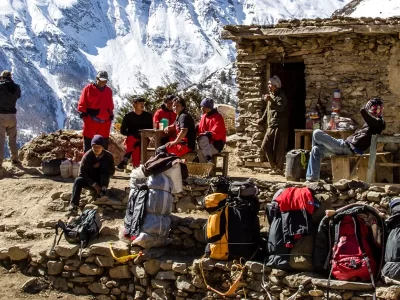Kathmandu Durbar Square – Things to know before visit
Kathmandu Durbar Square is the core of Kathmandu city, with many operating shops and restaurants. Kathmandu Durbar, Square-the biggest among other Durbar Squares (Patan and Bhaktapur), is a cultural and historical monument where several ancient temples are located, unique in their architecture.
In 1979, along with Patan and Bhaktapur Durbar Squares, Kathmandu Durbar Square was enlisted as World Heritage Site by UNESCO. This architectural landmark was built around the 3rd century BC by Licchavi Kings. They engaged Newar artisans and artists for the construction of most of the monuments in the square. Durbar Square has about 50 temples and monuments of various shapes, sizes, styles, and religions.
Everyday life in Kathmandu Durbar Square is in full swing; many locals pass through the square and drive on mopeds. There is always something new to the spot, learn, and discover around every corner.
The magnificent edifice surrounding the Durbar Square eloquently displays the Newar people’s centuries-long artistic and craftsmanship prowess.
The magnificent edifice surrounding the Durbar Square eloquently displays the Newar people’s centuries-long artistic and craftsmanship prowess.
History of Kathmandu Durbar Square
The Licchavi dynasty laid the foundation for constructing Kathmandu Durbar Square around the 3rd century. Later, Malla Dynasty and Shah Dynasty continued the expansion and beautification of the square. During the reign of King Ratna Malla, numerous royal palaces were built. However, Durbar Square only experienced its heyday under Prithvi Narayan Shah, who conquered the Kathmandu valley in 1769 and had numerous pagodas and palaces built on Durbar Square.
The square was the focal point for the then Royal family of Nepal. The coronation of the most beloved king of the Shah dynasty, Bir Bikram Shah, occurred in Kathmandu Durbar Square in 1975. The square also saw the crowning of the former king of the Shah dynasty Gyanendra Bir Bikram Shah.
Why Kathmandu Durbar Square?
Kathmandu Durbar Square is notably one of the most vital sights of Kathmandu due to its central location in the old town. Due to the numerous buildings worth seeing and the history associated with them, a visit accompanied by a tour guide is highly recommended. In this way, you can explore the most exciting buildings and learn more about the creation of the square and its cultural significance for the local people.
The infrastructure of Kathmandu Durbar Square
The Kathmandu Durbar Square area consists of three related areas. To the south is Basantapur Square, once a royal elephant stable. The main area of Kathmandu Durbar Square is situated to the west. On the other hand, the second part of Durbar Square lies to the northeast, where you will find entry to the Hanuman Dhoka and other temples. From this open space extends north-easterly Makhan Tole, once the city’s main thoroughfare and still the most exciting street in Kathmandu.
Kathmandu Durbar Square Entrance Fee
Located just 1 km from Thamel- a tourist hub of Kathmandu, Kathmandu Durbar square entrance fee is NPR 1000 per person for foreign nationals and NPR 150 for SAARC nationals. A ticket booth in Basantapur collects the entrance fee, which is then used for the restoration and maintenance of the square.
Recent Blog Posts

- September 23, 2023

- September 22, 2023

- September 22, 2023

